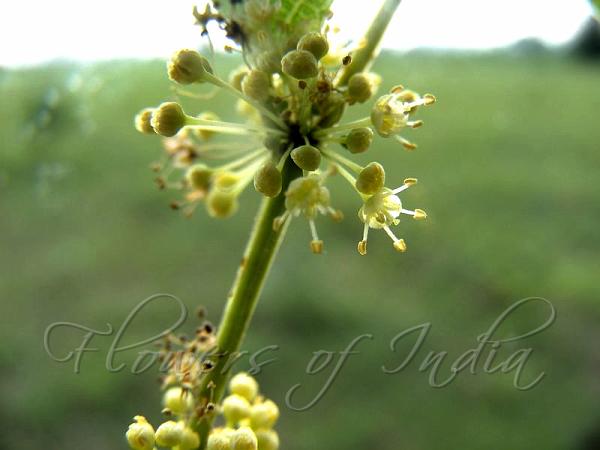|
| White-Berry Bush |
|

|

| File size | 77300 |
| Original date | 9/11/11 3:54 PM |
| Resolution | 3072 x 2304 |
| Flash | Flash did not fire, auto |
| Focal length | 6.3mm |
| Exposure time | 1/179s |
| Aperture | 4.0 |
| Focus Distance | 0.0m |
| Metering Mode | Multi-segment |
| Camera make | FUJIFILM |
| Camera model | FinePix S5700 S700 |
| Sensor type | OneChipColorArea |
|
|
|
|
Photo: |
Botanical name: Flueggea virosa Family: Phyllanthaceae (Amla family)
Synonyms: Phyllanthus virosus, Securinega virosa, Phyllanthus virosus
Synonyms: Phyllanthus virosus, Securinega virosa, Phyllanthus virosus
White-Berry Bush is a multistemmed, fast-growing,
bushy shrub, 2-3 m but sometimes a spreading tree up to 4 m high, with
some small, thorn-like branches. The bark is reddish brown to brown.
The leaves are green, crowded along the branchlets, alternate, elliptic
to obovate, thinly textured, 1.5-9 cm long, 1.2-5 cm wide. It bears
very small flowers which are creamy green. Fruit are white and fleshy
and appear in December-March. The slender branches are used to make
fish traps. The small fruit is sweet and eaten by people, animals and
birds when ripe. White-Berry Bush is native to Africa, Asia and
Australia. Flowering time: October-January.
Medicinal uses:  The roots and fruits are believed to be an effective snakebite remedy.
Roots of this plant are also used in some African communities as
contraceptives and for the treatment of syphilis, gonorrhoea,
rheumatism, sterility, rashes, and an infusion of the root is taken to
relieve malaria. The bark is believed to provide a treatment for
diarrhoea and pneumonia.
The roots and fruits are believed to be an effective snakebite remedy.
Roots of this plant are also used in some African communities as
contraceptives and for the treatment of syphilis, gonorrhoea,
rheumatism, sterility, rashes, and an infusion of the root is taken to
relieve malaria. The bark is believed to provide a treatment for
diarrhoea and pneumonia.
 The roots and fruits are believed to be an effective snakebite remedy.
Roots of this plant are also used in some African communities as
contraceptives and for the treatment of syphilis, gonorrhoea,
rheumatism, sterility, rashes, and an infusion of the root is taken to
relieve malaria. The bark is believed to provide a treatment for
diarrhoea and pneumonia.
The roots and fruits are believed to be an effective snakebite remedy.
Roots of this plant are also used in some African communities as
contraceptives and for the treatment of syphilis, gonorrhoea,
rheumatism, sterility, rashes, and an infusion of the root is taken to
relieve malaria. The bark is believed to provide a treatment for
diarrhoea and pneumonia. | Identification credit: Siddarth Machado, N Arun Kumar | Photographed in Panipat, Haryana & Karnataka. |
• Is this flower misidentified? If yes,